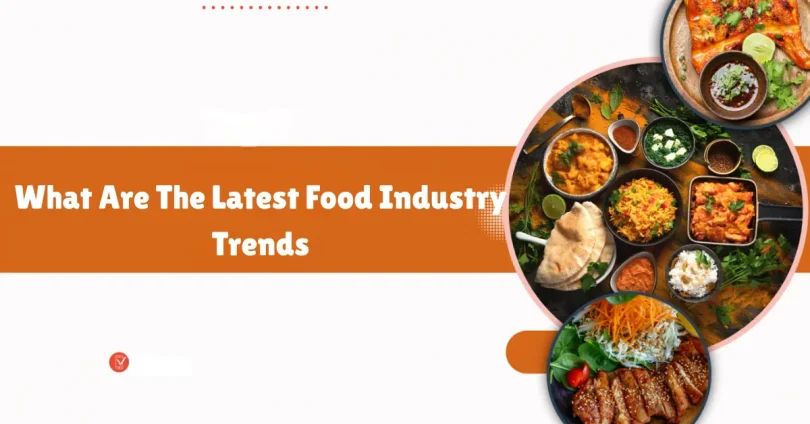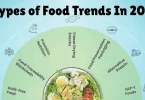The food industry is changing faster than ever, driven by evolving consumer preferences, technological advancements, and a growing awareness of health and sustainability.
Whether you’re a foodie, a restaurant owner, or someone interested in healthier eating habits, understanding what are the latest food industry trends can give you a clear view of where the market is headed.
In this guide, we’ll break down the biggest trends shaping the food world today.
1. Health-Focused Choices

Consumers today are far more health-conscious than a decade ago. It’s no longer enough for food to just taste good—people want products that actively support their well-being. Some of the key health-driven trends include:
Plant-Based Foods and Alternative Proteins
Plant-based diets are no longer niche. Sales of plant-based meat alternatives and dairy substitutes have surged in recent years. Foods like soy-based meats, pea protein products, oat milk, and jackfruit dishes are gaining mainstream popularity. Companies like Beyond Meat and Impossible Foods are leading this movement, but smaller brands are also innovating with lentils, beans, and other sustainable protein sources.
Gut Health and Functional Ingredients
Gut health has become a priority for many consumers. Probiotics, prebiotics, fermented foods like kimchi and kombucha, and fiber-rich ingredients are now staples for those looking to improve digestion and immunity. Functional beverages—drinks enhanced with vitamins, minerals, or adaptogens—are also growing rapidly in popularity.
Clean Labeling
Transparency in food has become a deal-breaker for many shoppers. Products with clear, simple ingredients, free from artificial additives or preservatives, are increasingly favored. Labels that highlight “non-GMO,” “organic,” or “no artificial colors” appeal directly to the health-conscious consumer.
2. Personalization in Nutrition
One of the most exciting trends in the food industry is personalized nutrition. Consumers are moving away from generic diets and seeking food experiences tailored to their individual needs.
- Customized Meal Kits: Brands are offering meal kits based on dietary goals—whether it’s keto, vegan, high-protein, or gluten-free. These kits make it easy to stick to a specific diet without sacrificing taste.
- DNA-Based Nutrition: Some companies now provide meal recommendations based on genetic analysis, helping people choose foods that align with their metabolism and health goals.
- Nutrition Apps and Tracking Tools: Digital apps are helping consumers track nutrient intake, water consumption, and even sleep patterns to optimize overall wellness.
Personalization allows food to become not just a source of sustenance, but a tool for maintaining and improving health.
3. Technology Driving Change
Technology is transforming every stage of the food supply chain—from production to consumption. Here’s how:
- Artificial Intelligence (AI): AI is helping restaurants predict customer preferences, optimize menus, and even forecast ingredient demand. For example, AI can help reduce food waste by analyzing ordering patterns.
- Digital Food Management Systems: These systems streamline operations, including inventory management, temperature monitoring, and quality control, making food production safer and more efficient.
- Resilient Supply Chains: Technology is helping companies respond quickly to disruptions, track shipments in real-time, and reduce delays caused by global supply chain challenges.
In essence, technology is making the food industry smarter, safer, and more responsive to consumer needs.
4. Sustainability and Ethical Practices
Sustainability is no longer optional—it’s expected. Consumers are increasingly concerned about the environmental impact of their food choices, as well as ethical sourcing practices.
Local and Ethical Sourcing
People are gravitating towards products that support local farmers and communities. Ethically sourced coffee, chocolate, and seafood are becoming increasingly common, reflecting a shift towards responsible consumption.
Sustainable Packaging
Eco-friendly packaging, including biodegradable containers, reusable materials, and recyclable packaging, is now a key selling point for many brands. Companies are recognizing that consumers care about the environmental footprint of their products.
Reducing Food Waste
Food waste is a global problem, and brands are taking active steps to combat it. Solutions range from imperfect produce sales to better inventory planning and donation programs for unsold food.
You may also like to read this:
How To Read Nutrition Facts Properly: Full Guide
Types of Hidden Ingredients In Processed Foods You Must Know
Why Calories on Labels Can Be Confusing Explained
Best Apps To Check Nutrition Facts For Healthy Eating
10 Top Nutrition Facts People Often Ignore To Eat Smarter
5. Flavor Innovation and Cultural Exploration
While health and sustainability dominate the market, consumers still crave exciting flavors and culinary experiences. Food brands are experimenting with:
- Fusion Cuisines: Mixing flavors from different cultures creates unique taste experiences. Think Korean-Mexican tacos or Japanese-Italian ramen pizza.
- Bold Spices and Herbs: Spices like sumac, za’atar, turmeric, and smoked paprika are becoming household favorites.
- Ready-to-Eat Gourmet Options: Pre-packaged meals are being elevated with chef-inspired recipes that combine convenience with premium taste.
Flavor exploration is allowing consumers to enjoy both nutrition and adventure in every bite.
6. Convenience and On-the-Go Options
Modern lifestyles demand food that fits into busy schedules without sacrificing quality. Convenience trends include:
- Meal Kits and Subscriptions: Ready-to-cook kits with pre-measured ingredients save time while offering variety and freshness.
- Healthy Snacks and Beverages: Portable protein bars, energy drinks, and nutrient-rich snacks cater to busy consumers.
- Ready-to-Cook and Ready-to-Eat Products: Fresh, high-quality meals that are easy to heat or prepare are more popular than ever.
The demand for convenience is pushing innovation in packaging, portioning, and delivery methods.
7. Functional Beverages and Alternative Drinks
Beverages are no longer just about quenching thirst—they’re becoming functional tools for wellness. Consumers are increasingly seeking drinks that offer health benefits, including:
- Adaptogenic Drinks: Beverages infused with herbs like ashwagandha, holy basil, and ginseng that help the body manage stress.
- Enhanced Waters: Vitamin-enriched, electrolyte-balanced, or flavored waters that promote hydration and nutrition.
- Non-Dairy Alternatives: Almond, oat, and soy milk continue to grow in popularity, especially when fortified with calcium, protein, and other nutrients.
Functional drinks reflect a broader trend where food and beverages are integrated into a holistic wellness lifestyle.
8. Rise of Ethical Snacking

Snacking has transformed from indulgence to intentional nutrition. Modern consumers are looking for snacks that are:
- Nutritious: High in protein, fiber, or healthy fats.
- Ethically Produced: Fair-trade chocolate, responsibly sourced nuts, and organic ingredients appeal to conscious consumers.
- Innovative: Snacks using alternative ingredients like chickpeas, seaweed, or cricket protein are gaining traction.
The snacking market is responding by blending health, taste, and sustainability into every bite.
9. Experience-Driven Dining
Even in the age of convenience, many consumers crave unique dining experiences:
- Interactive Dining: Restaurants offering DIY meals, tasting menus, or chef-led cooking experiences are becoming popular.
- Cultural Exploration: Consumers want authentic international dishes that introduce them to new culinary traditions.
- Pop-Ups and Experiential Retail: Temporary food events and immersive brand experiences are engaging customers in innovative ways.
Food is no longer just fuel; it’s entertainment, education, and exploration rolled into one.
10. Global Flavors Going Mainstream
The globalization of cuisine is accelerating. Ingredients and dishes that were once considered exotic are now part of everyday menus:
- Asian-Inspired Dishes: Ramen, bao buns, and Korean barbecue have moved from niche to mainstream.
- Middle Eastern and African Flavors: Ingredients like tahini, harissa, and teff are gaining attention in Western markets.
- Plant-Based International Cuisine: Meatless versions of global classics are becoming increasingly available.
Consumers are embracing diversity in taste while maintaining a focus on nutrition and sustainability.
11. Smart Packaging and Shelf Life Innovation
Packaging isn’t just for presentation—it’s also a tool for innovation and sustainability:
- Smart Packaging: QR codes on packaging provide ingredient transparency, sourcing information, and cooking instructions.
- Shelf Life Extension: Technologies like vacuum sealing, modified atmosphere packaging, and natural preservatives help reduce waste.
- Eco-Conscious Materials: Biodegradable plastics, compostable wraps, and reusable containers are meeting consumer demand for green solutions.
Packaging now balances practicality, sustainability, and customer engagement.
Key Takeaways for Food Businesses
Understanding what are the latest food industry trends is essential for anyone involved in the market. Here are some actionable insights:
- Invest in Health-Oriented Products: Plant-based options, functional foods, and clean-label products are not just trends—they’re here to stay.
- Embrace Technology: From AI to supply chain innovations, technology enhances efficiency, reduces waste, and meets consumer expectations.
- Prioritize Sustainability: Ethical sourcing, eco-friendly packaging, and waste reduction appeal to socially conscious consumers.
- Offer Personalization: Customized nutrition solutions, subscription meal services, and flexible offerings create loyal customers.
- Experiment with Flavors: Bold spices, global cuisines, and innovative snacks attract adventurous eaters.
- Focus on Convenience: Ready-to-cook meals, functional beverages, and portable snacks cater to busy lifestyles.
Conclusion
So, what are the latest food industry trends? In short, health, personalization, technology, sustainability, flavor innovation, and convenience are driving the market forward. From plant-based foods to AI-driven kitchens, the food industry is moving toward a future that prioritizes well-being, environmental responsibility, and tailored consumer experiences.
Whether you’re exploring new foods, starting a food business, or simply curious about what’s next in the market, staying aware of these trends will help you make smarter choices and stay ahead of the curve.
FAQs
1. What are the key trends in the food industry today?
The latest food industry trends focus on health, personalization, technology, sustainability, flavor innovation, and convenience. Consumers are seeking plant-based options, functional foods, ethical sourcing, and tech-driven solutions for better eating experiences.
2. Why is plant-based food becoming so popular?
Plant-based foods are gaining popularity due to health benefits, environmental concerns, and ethical reasons. Alternative proteins like soy, pea protein, and jackfruit provide nutritious, sustainable options for consumers.
3. How is technology impacting the food industry?
Technology is reshaping production, distribution, and consumption. AI helps predict trends and reduce waste, digital food management systems streamline operations, and smart supply chains ensure timely delivery and safety.
4. What is personalized nutrition and why does it matter?
Personalized nutrition tailors diets and meal plans to individual needs, lifestyles, or genetic profiles. It allows consumers to optimize health, manage weight, and improve overall wellness.
5. How are sustainability and ethical practices influencing food trends?
Consumers increasingly prefer locally sourced, ethically produced foods and eco-friendly packaging. Brands reducing food waste, using sustainable materials, and supporting communities are gaining consumer trust.





